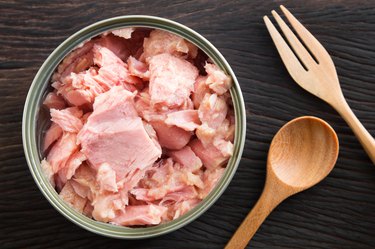
Popping open a can of tuna and whipping up a tuna salad for either a sandwich or salad is an easy way to fill up and get a significant amount of protein and omega-3 fats at the same time. However, not all tuna is equal.
Understand the Difference
Video of the Day
It's easy to buy a can of tuna based on its cost alone, if you're on a budget. Chunk light tuna can be had for as little as a couple of dollars for a 12 ounce can, according to Walmart's website. The same amount of white albacore tuna will have you shelling out around a buck more at the same store.
Video of the Day
Read more: The Danger in Eating Too Much Canned Tuna
That doesn't automatically mean that albacore is the better tuna for your body. White albacore tuna is made specifically from that species of fish, whereas chunk light tuna can hail from a number of species, according to Bumblebee, one of the most commonly-eaten brands in the tuna industry.
Albacore tuna is a bigger fish — up to roughly 5 feet long, according to the University of California, San Diego Sea Grant — which means that it swims deeper in the ocean. Instead of being scooped up in a purse seine like the smaller species of the fish that are used for chunk light tuna, a deep-sea fishing technique with a long line captures one fish at a time. The flesh has a light white color and a meaty texture that presents in the can as either a fish steak (solid white albacore) or large chunks (chunk white albacore).
Chunk light tuna hails primarily from skipjack tuna, which are mature at just 1 year old and 16 inches long, according to the University of California, San Diego Sea Grant. By contrast, albacore need 5 to 6 years to reach maturity, making the smaller, faster-reproducing species more sustainable. The smaller chunk light species could include other small species such as yellow-fin and big-eyed tuna, and the end product is pinker in color, flakier and has a stronger flavor than the white albacore.
Calculate the Nutrition
If you're counting calories, chunk light tuna in water offers the fewest, with just 82 calories per 3.5 ounces, according to the USDA. This serving size delivers 19 grams of protein and just over a half-gram of fat.
Other nutrients in chunk light tuna in water include 224 milligrams of potassium and 1.27 milligrams of iron. There are no carbohydrates in chunk light tuna, making it an optimal choice for those following a ketogenic diet.
Albacore tuna in water has 108 calories per 3.5-ounce serving, according to USDA as well as a slightly higher protein profile, at 23 grams. It serves up 338 milligrams of potassium, 95 micrograms of selenium, 54 international units of vitamin D and 12 milligrams of niacin. Like chunk light tuna, albacore contains no carbohydrates and delivers 1.35 grams of fat.
Chunk light tuna has more sodium than albacore, however. Each 3.5-ounce serving contains 376 milligrams, compared to 95 milligrams in the white albacore variety.
Know the Risks
As with most ocean-caught fish, mercury can be a concern. According to a June 2019 study published by the Society of Environmental Toxicology and Chemistry, hair mercury levels in university students consuming tuna three to 20 times per week were significantly higher than in non-tuna eating students, with those eating the most tuna having mercury levels of concern.
Mercury levels from eating tuna are of particular concern when it comes to pregnant and nursing women and small children. The U.S. Food and Drug Administration (FDA) recommends 8 to 12 ounces of seafood per week for pregnant or nursing women. The FDA's recommendation cites high levels of protein, vitamin D, selenium, B12, omega 3 fats and trace minerals.
However, chunk light tuna is the only type of tuna recommended by the FDA as a "best choice," with two to three servings per week considered safe for consumption. White albacore tuna is a "good choice," but only recommended for consumption once a week, due to its higher mercury levels, which can be up to three times the amount of yellowfin tuna mercury, or that found in other fish, according to the University of California, San Diego.
- University of California, San Diego Sea Grant: "Pacific Skipjack Tuna"
- Society of Environmental Toxicology and Chemistry: "Tuna Consumption, Mercury Exposure, and Knowledge about Mercury Exposure Risk from Tuna Consumption in University Students"
- U.S. Food and Drug Administration: "Advice About Eating Fish"
- Walmart: "Chicken of the Sea Chunk Light Tuna in Water"
- Starkist: "Chunk Light Tuna in Water"
- Starkist: "Solid White Albacore Tuna in Water"
- U.S. Department of Agriculture Food Data Central: "Chunk Light Tuna in Water."
- U.S. Department of Agriculture FoodData Central: "White Albacore Tuna in Water"